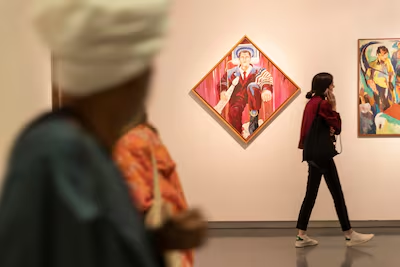Art has always been an essential expression of human creativity and cultural identity. Throughout history, artists have relied on patrons to support and nourish their endeavours. These patrons – whether they are people, institutions or governments – have played a crucial role in sustaining art ecosystems. By supporting artists financially, patrons enable artists to reach their full potential, but they also elevate artists's profiles by providing platforms and opportunities for their work to be seen and appreciated by others.
The practice of patronage is not new. It dates back to the time of Islamic empires when patrons contributed to the evolution and richness of the arts and cultural life in this part of the world.
The Islamic world has a rich history of art patronage, with a legacy that has influenced and shaped the artistic landscape globally. Islamic patrons recognised the significance of art as a means of expressing religious devotion, celebrating beauty and fostering cultural exchange. Their support allowed artists to flourish and reach extraordinary heights – whether in architecture, calligraphy, manuscript illumination, or the decorative arts.
Mosques, palaces, and madrasas were commissioned and adorned with intricate tile work, stucco carvings and calligraphy. These architectural marvels served as both religious spaces and artistic expressions, embodying the aesthetic and spiritual values of Islamic culture.
The art of manuscript illumination thrived under Islamic patronage, with Qurans and other religious texts being embellished with ornate patterns, illuminations and miniature paintings. These exquisitely decorated manuscripts were seen as sacred objects which combined artistic beauty and religious significance. From the Abbasid Caliphate (750–1258) to the Mughal Empire from the 16th to the 19th century, patrons provided artists with financial support, networks, and protection, allowing them to dedicate themselves to their craft.
Here in the UAE, there is a similar tradition of patronage most prevalent within the ruling families of the various emirates, each investing in the arts and cultural life of the UAE. This patronage often comes by way of an individual or family run foundations. In light of the 15th Sharjah Art Biennial and the UAE pavilion’s fifth participation in the Venice Architecture Biennial, it is necessary to recognise the importance of continuing the legacy of patronage of the arts over the past three decades.
The Sharjah Art Foundation, the Salama bint Hamdan Al Nahyan Foundation, the Barjeel Art Foundation and Tashkeel have contributed immensely in their own ways to ensure that artists benefit and their endeavours flourish.

Other notable private foundations include families that impact their communities with significant long-term endowment of their wealth to arts-related initiatives. Some successful examples in the UAE include the Al Serkal Foundation, Art Jameel, ADMAF and the Sultan Al Owais Cultural Foundation.
It is important, however, to note that patronage not only encompass financial contributions but can and should include other avenues that help support both established and emerging artists.
In the many years that I have been working in the cultural sector, artists have occasionally lamented the lack of support for them to create works, exhibit them and sell them for a living. A number of factors have led to this, including a narrow interest in particular art mediums (such as film, performance or literature), poor communication of grant opportunities (when available), and limited art venues for exhibiting works. Fortunately, much has changed in recent years with above mentioned foundations, in particular, expanding the variety of support and ensuring the development of numerous new venues and art spaces.
Besides the obvious financial support, patrons offer artists the opportunity to experiment and explore new directions, playing a crucial role as advocates for artists, which then raises their profiles within the art community and among the wider public. Patrons are essential to artists as they encourage artistic freedom and create environments that enable artists to push boundaries and explore progressive ideas.
In some cases, patrons can also provide necessary mentorship and guidance to artists based on their knowledge and experience, offering feedback and facilitating connections with other professionals and institutions. This support is instrumental for an artist's inner growth.
As individuals, art patrons have the power to nurture emerging talents. They can commission artworks, fund scholarships, and provide mentorship to aspiring artists.
Institutional patrons, such as museums and foundations, bring stability and credibility to the arts community. They provide platforms for artists to showcase their work through exhibitions. These institutions not only celebrate artistic activity but also act as vehicles for cultural exchange and artistic discourse.
To encourage others to become patrons, it is essential to promote the value and impact of art in society. Raising awareness about the transformative power of art and the positive effects of patronage can inspire individuals and institutions to be more active. Offering diverse opportunities for engagement, such as supporting small to medium art projects, connecting artists to others via their networks, purchasing an artist’s works, offering spaces for them to exhibit, or sponsoring artist residencies are ways in which patrons can get involved.
By showcasing success stories and recognising the contributions of patrons, we can inspire others to join the cause and become active participants in building a thriving arts community in the UAE and ensuring a vibrant future for the arts.

